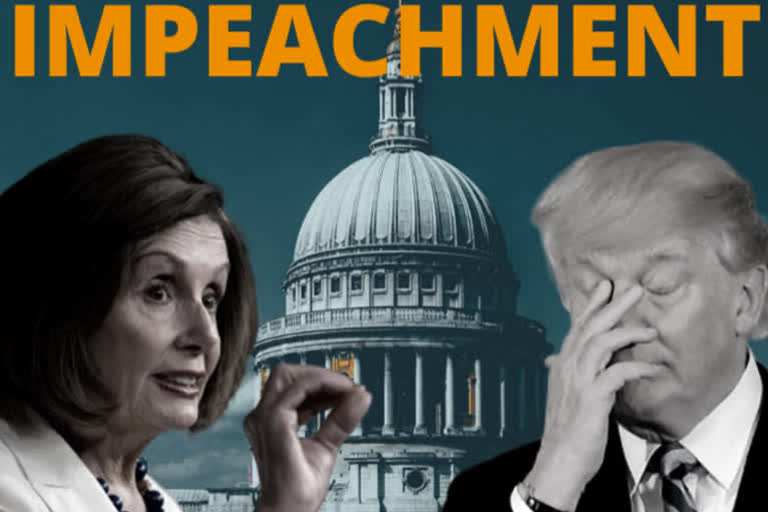Washington: US House Republicans on Monday (local time) blocked a request by Democrats to unanimously pass a resolution seeking Vice President Mike Pence to invoke the 25th Amendment to remove President Trump from power, following a violent breach of the US Capitol by the president's supporters last week.
According to The Hill, during a brief session on the floor, Democratic Majority Leader Steny Hoyer asked that the resolution, authored by fellow Maryland Democratic Representative Jamie Raskin, a constitutional scholar, be passed unanimously. The resolution called on Pence to "convene and mobilize" the Cabinet, declare Trump unfit to carry out his duties, and vote to strip the president of his powers under Article 4 of the 25th Amendment.
However, Republican Representative Alex Mooney objected to Hoyer's request. Mooney said he opposed Democrats rushing to pass a "resolution of this magnitude" with no debate.
"Speaker Pelosi should not attempt to adopt a resolution of this magnitude without any debate on the floor of the US House of Representatives. It is wrong to have sent members of Congress home and then try to adopt without any debate a precedent-setting resolution that could imperil our Republic," Mooney said in a statement.
After the exchange on the floor, Hoyer told reporters that the full House will vote on the rule for the resolution Tuesday and vote for final passage on Tuesday evening. That would force Republicans to go on record three times opposing the 25th Amendment resolution, Democrats said.
Speaker Nancy Pelosi repeatedly has said that she favours Pence invoking the 25th Amendment to quickly remove Trump after Wednesday's deadly insurrection, reported The Hill.
Meanwhile, House Democrats have introduced a resolution to impeach US President Donald Trump on Monday, on charges of "incitement of insurrection" during the Capitol riots. Chaotic and violent scenes erupted at the Capitol on Wednesday as supporters of Trump stormed the building to protest the Electoral College vote, forcing a lockdown and confrontations with the police.
Wednesday's violence came hours after Trump encouraged his supporters to fight against the election results as Congress was certifying Biden's victory in the November vote.
Some questions and answers about the 25th Amendment:
WHY WAS IT PASSED?
The push for an amendment detailing presidential succession plans in the event of a president’s disability or death followed the assassination of President John F. Kennedy in 1963. President Lyndon B. Johnson in his 1965 State of the Union promised to “propose laws to insure the necessary continuity of leadership should the President become disabled or die.” The amendment was passed by Congress that year and ratified in 1967.
HAS THE 25TH AMENDMENT BEEN INVOKED BEFORE?
Yes, presidents have temporarily given up power, but those instances have been generally been brief and voluntary, for example when the president was having a medical procedure.
In 2002, President George W. Bush became the first to use the amendment’s Section 3 to temporarily transfer power to Vice President Dick Cheney while Bush was anaesthetized for a colonoscopy. Section 4 of the amendment, which allows the Cabinet to declare the president unfit, has never been invoked.
HOW CAN THE CABINET DECLARE THE PRESIDENT UNFIT?
The 25th Amendment’s Section 4 lays out what happens if the president becomes unable to discharge his duties but doesn’t transfer power to the vice president himself.
The vice president and majority of the Cabinet can declare the president unfit. They then would send a letter to the speaker of the House and president pro tempore of the Senate saying so. The vice president then becomes acting president.
The president can send his own letter saying he is fit to serve. But if the vice president and majority of the Cabinet disagree, they can send another letter to Congress within four days. Congress would then have to vote. The president resumes his duties unless both houses of Congress by a two-thirds vote say the president is not ready.
ISN’T THERE SOME OTHER LEGISLATION ABOUT THIS?
Section 4 of the amendment also gives Congress the power to establish a “body” that can, with the support of the vice president, declare that the president is unable to do the job. If they agree the president is unfit, the vice president would take over. But Congress has never set up the body.
In October, House Speaker Nancy Pelosi, D-Calif., announced legislation that proposed the creation of a commission to fill that role. The legislation would set up a 16-member bipartisan commission chosen by House and Senate leaders. It would include four physicians, four psychiatrists and eight retired public figures such as former presidents, vice presidents and secretaries of state. Those members would then select a 17th member to act as a chair.
After the commission was in place, Congress would be able to pass a resolution requiring the members to examine the president, determine whether the president is incapacitated and report back.
With inputs from agency
Also Read: US House Speaker calls for invoking 25th Amendment to remove Trump from office



